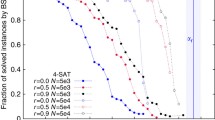Abstract
In the Max FS problem, given an infeasible linear system A x ≥ b, one wishes to find a feasible subsystem containing a maximum number of inequalities. This NP-hard problem has interesting applications in a variety of fields. In some challenging applications in telecommunications and computational biology one faces very large Max FS instances with up to millions of inequalities in thousands of variables. We propose to tackle large-scale instances of Max FS using randomized and thermal variants of the classical relaxation method for solving systems of linear inequalities. We present a theoretical analysis of one particular version of such a method in which we derive a lower bound on the probability that it identifies an optimal solution within a given number of iterations. This bound, which is expressed as a function of a condition number of the input data, implies that with probability 1 the randomized method identifies an optimal solution after finitely many iterations. We also present computational results obtained for medium- to large-scale instances arising in the planning of digital video broadcasts and in the modelling of the energy functions driving protein folding. Our experiments indicate that these methods perform very well in practice.
Access this chapter
Tax calculation will be finalised at checkout
Purchases are for personal use only
Preview
Unable to display preview. Download preview PDF.
Similar content being viewed by others
References
Amaldi, E.: The maximum feasible subsystem problem and some applications. In: Agnetis, A., Di Pillo, G. (eds.) Modelli e Algoritmi per l’ottimizzazione di sistemi complessi, Pitagora Editrice Bologna (2003)
Amaldi, E., Hauser, R.: Boundedness theorems for the relaxation method. Under minor revision for Mathematics of Oper. Res., available from Optimization Online
Amaldi, E., Kann, V.: The complexity and approximability of finding maximum feasible subsystems of linear relations. Theoretical Computer Science 147, 181–210 (1995)
Amaldi, E., Pfetsch, M.E., Trotter Jr., L.E.: On the maximum feasible subsystem problem, IISs and IIS-hypergraphs. Math. Programming A 95, 533–554 (2003)
Bennett, K.P., Bredensteiner, E.: A parametric optimization method for machine learning. INFORMS Journal on Computing 9, 311–318 (1997)
Block, H.D., Levin, S.A.: On the boundedness of an iterative procedure for solving a system of linear inequalities. In: Proceedings of AMS, pp. 229–235 (1970)
Censor, Y., Zenios, S.A.: Parallel Optimization: Theory, algorithms and applications. Oxford University Press, Oxford (1997)
Chinneck, J.: Fast heuristics for the maximum feasible subsystem problem. INFORMS Journal on Computing 13, 210–213 (2001)
Codato, G., Fischetti, M.: Combinatorial Benders’ cuts. In: Bienstock, D., Nemhauser, G.L. (eds.) IPCO 2004. LNCS, vol. 3064, pp. 178–195. Springer, Heidelberg (2004)
Dunagan, J., Vempala, S.: A simple polynomial-time rescaling algorithm for solving linear programs. In: Proceedings of STOC, pp. 315–320. ACM Press, New York (2004)
Frean, M.: A “thermal” perceptron learning rule. Neural Comp. 4(6), 946–957 (1992)
Goffin, J.L.: The relaxation method for solving systems of linear inequalities. Mathematics of Oper. Res. 5, 388–414 (1980)
Greenberg, H.J., Murphy, F.H.: Approaches to diagnosing infeasible linear programs. ORSA Journal on Computing 3, 253–261 (1991)
Lee, E.K., Gallagher, R.J., Zaider, M.: Planning implants of radionuclides for the treatment of prostate cancer: An application of MIP. Optima 61, 1–7 (1999)
Mangasarian, O.: Machine learning via polyhedral concave minimization. In: Fischer, H., et al. (eds.) Applied Mathematics and Parallel Computing, pp. 175–188. Physica-Verlag, Heidelberg (1996)
Mattavelli, M., Noel, V., Amaldi, E.: Fast line detection algorithms based on combinatorial optimization. In: Arcelli, C., Cordella, L.P., Sanniti di Baja, G. (eds.) IWVF 2001. LNCS, vol. 2059, pp. 410–419. Springer, Heidelberg (2001)
Meller, J., Wagner, M., Elber, R.: Solving huge linear programming problems for the design of protein folding potentials. Math. Programming B 101, 301–318 (2004)
Minsky, M.L., Papert, S.: Perceptrons: An introduction to computational Geometry Expanded edition. MIT Press, Cambridge (1988)
Nedić, A., Bertsekas, D.: Incremental subgradient methods for nondifferentiable optimization. SIAM J. on Optimization 12, 109–138 (2001)
Pfetsch, M.E.: The maximum feasible subsystem problem and vertex-facet incidences of polyhedra. PhD thesis, Dep. of Mathematics, Technische Universität Berlin (October 2002)
Polyak, B.T.: Random algorithms for solving convex inequalities. In: Butnariu, D., et al. (eds.) Inherently parallel algorithms in feasibility and other applications. Elsevier, Amsterdam (2001)
Rossi, F., Sassano, A., Smriglio, S.: Models and algorithms for terrestrial digital broadcasting. Ann. of Oper. Res. 107(3), 267–283 (2001)
Schrijver, A.: Theory of Linear and Integer Programming. Wiley & Sons, Chichester (1986)
Author information
Authors and Affiliations
Editor information
Editors and Affiliations
Rights and permissions
Copyright information
© 2005 Springer-Verlag Berlin Heidelberg
About this paper
Cite this paper
Amaldi, E., Belotti, P., Hauser, R. (2005). Randomized Relaxation Methods for the Maximum Feasible Subsystem Problem. In: Jünger, M., Kaibel, V. (eds) Integer Programming and Combinatorial Optimization. IPCO 2005. Lecture Notes in Computer Science, vol 3509. Springer, Berlin, Heidelberg. https://doi.org/10.1007/11496915_19
Download citation
DOI: https://doi.org/10.1007/11496915_19
Publisher Name: Springer, Berlin, Heidelberg
Print ISBN: 978-3-540-26199-5
Online ISBN: 978-3-540-32102-6
eBook Packages: Computer ScienceComputer Science (R0)




